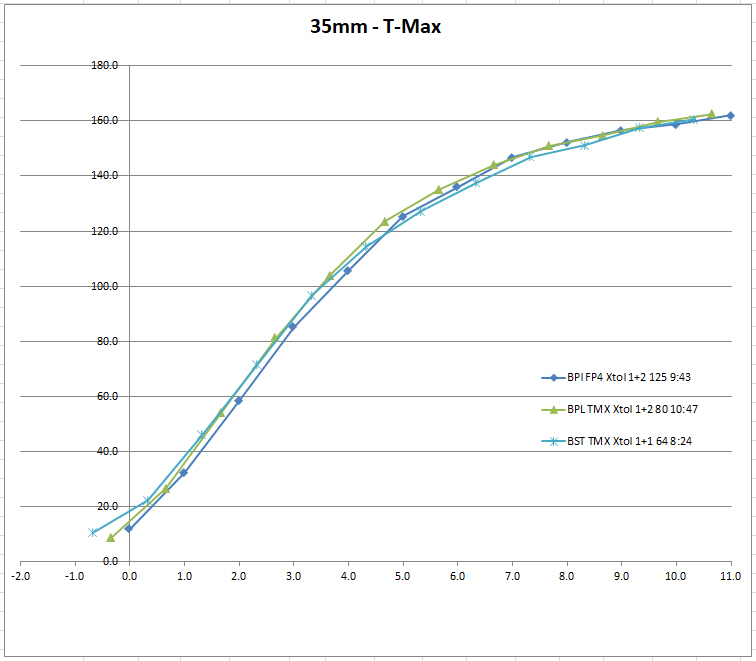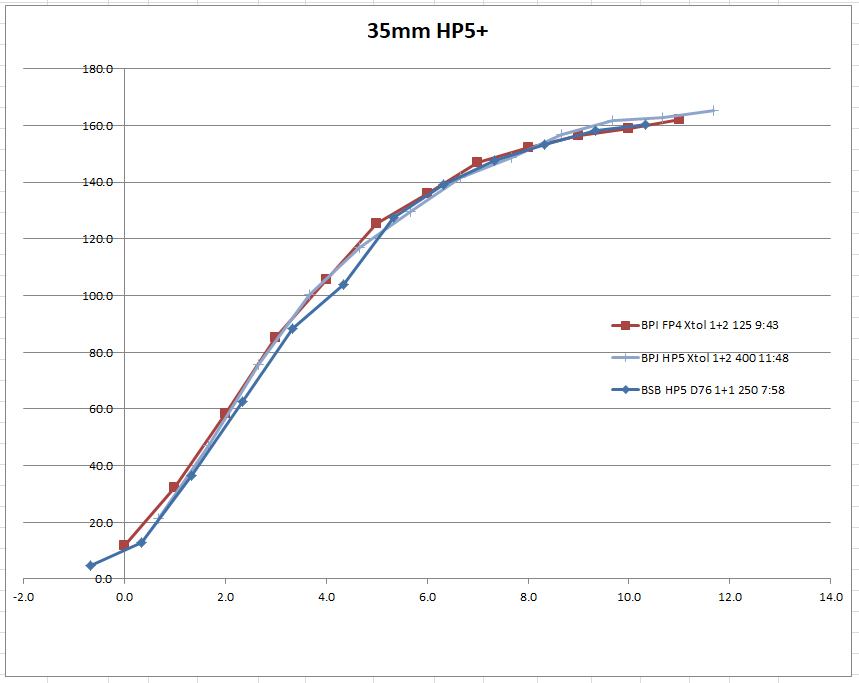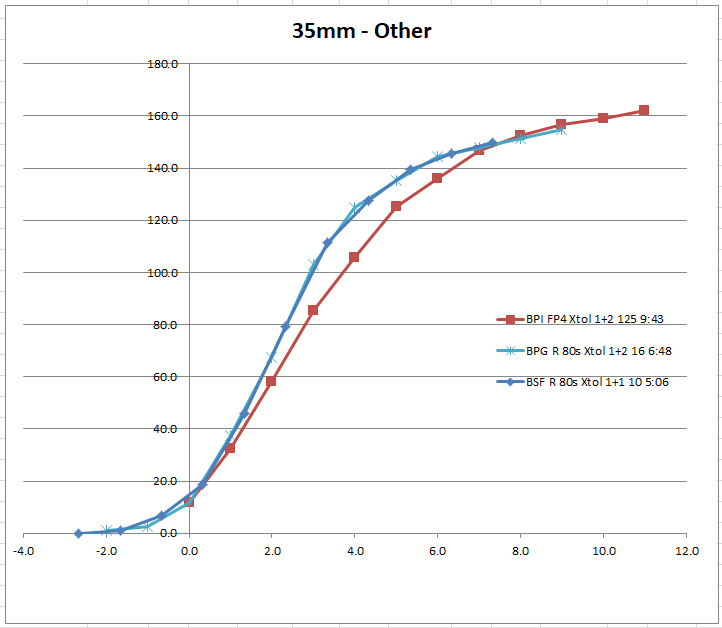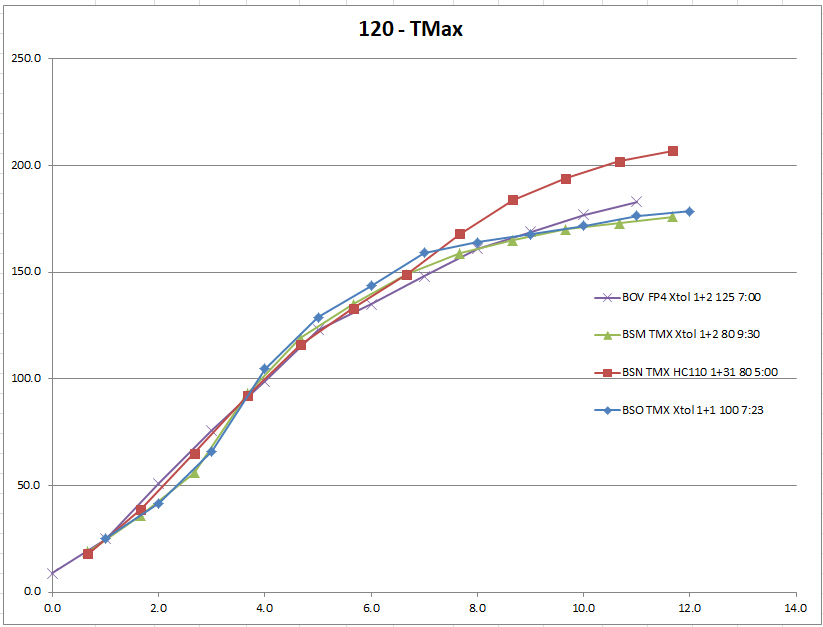Film compare - Ilford FP4+ 125 vs Kodak TMax 100
Nov 10, 2023 12:53:44 #
Introduction
The images, below, are not back to back, nor shot with exactly the same settings. They are from the same event in July 2022, over a roughly 90-minute session. The two films - Ilford FP4+ 125 and Kodak TMax 100 -- are both considered very fine-grain and sharp. These attributes I wanted to use and see (in the results) of shooting people.
I've tried to find visually similar images to allow for a comparison of results. Both films were shot with the same camera and lens: EOS 1v and EF 24-70mm f/2.8L II USM. Both films were shot 1/3-stop 'slower' than box speed, that is, over-exposed by 1/3-stop. The negatives were scanned to roughly 17MP JPEGs and edited digitally in Adobe Lightroom 6. Finally, the JPEGs are resized to 2048px on the long-side and posted to Flickr.
Comparison 1
The first roll shot was the TMAX-100, where I overrode the canister DX code to ISO-080 in the camera. The band was warming- and tuning-up for a short trip to a local July 4 parade. Because of the time-sequence, I don't have this same time period (subject and light) captured to both film types. So, in this first comparison, I'm looking for relatively equal-distance views of people / subjects.
For this comparison, and all the subsequent pairings, the TMAX image is presented first, followed by the FP4+. The images appear as 1600px wide links from Flickr. The slightly larger 2048px versions can be found on the host Flickr page, just use the URL link (title) to access Flickr for each image.
(TMAX) Shannon Rovers - July 4

(FP4+) Shannon Rovers - July 4

Observations
The Ilford image has more contrast, although the drummer is now marching down the middle of the street while the pipers are tuning up in a slightly shaded area under a tree. Comparison 04, below, presents two images, both in shaded light, more clearly showing the Ilford film always giving more contrast.
Both films are virtually grain-free. Both films are considered very sharp for 35mm negative B&W film, although the higher contrast of Ilford can make those images seem sharper. Even in these resized (lower) resolution images, you can see the fine details of the instruments in the zoomed details.
Comparison 2
This comparison is the best I could find of two similar views of the color guard. Although both use an f/6.3 aperture, the light seems slightly different and the shutter speed on the TMAX is slower, where the subject is moving.
(TMAX) Shannon Rovers - July 4

(FP4+) Shannon Rovers - July 4

Regarding film grain
The Kodak TMax family (ISO ratings 100, 400, and 3200) use a tabular grain (T-grain) similar to virtually all color film types. The Ilford FP4+ uses a more traditional cubic grain. T-grain B&W film is relatively new, introduced by Kodak in the 1980s, and limited to certain films from Kodak, Ilford and others, where the majority of B&W film types retain a cubic grain. Some reviewers of the TMax films feel these films seem more like digital images converted to B&W, rather than film captures, given how 'clean' the scans appear, as well as the lower contrast between the darker and brighter areas of the image.
Comparison 3
These two images might be the closest together in clock time, near the end of the TMax roll and the start of the FP4+ roll. Similar to above, I prefer the Ilford image of the two. But, the slower ISO applied to the TMax, and maybe still a bit less light / more cloud at the moment, are causing some of the differences in the TMax, rather than a visual & technical difference in the two films.
(TMAX) Shannon Rovers - July 4

(FP4+) Shannon Rovers - July 4

about Ilford FP4+
The original Ilford Fine-Grained Panchromatic was released in 1935 (FP for short). Modified versions occurred over the years, reaching FP4 in 1968 and the current FP4+ in 1990. The film is known for the contrast shown in these images, as well as the 'classic' cubic grain, although that 'grain' is very modest in all these examples.
Comparison 4
These two versions of the bass drum might be the closest in a shaded light for both images. Again, we see more contrast in the Ilford image. The distance to the subject is a bit different, but we can clearly see, in both images, the fine details of the lugs and tension rods (hardware) holding the drum heads together.
(TMAX) Shannon Rovers - July 4

(FP4+) Shannon Rovers - July 4

Conclusion
I had not performed any such detailed analysis of these films prior to selecting which rolls to bring to the parade. I'd simply read about how sharp the two films were expected to perform, having rarely -- and only randomly -- used both film types in earlier situations. If I had it to do over again, I would have used the higher contrast FP4+ as the first roll, or just skipped the TMax 100 altogether. When I filter my LR catalog to find TMax-100 tagged images, I see only static subjects like flowers, architecture, landscapes and such, never any moving people. When I look at the TMax-100 images from other situations, I also see the use of color (contrast) filters to add more contrast to this Kodak film.
Here's one final bonus image from the Ilford roll, something that shows off the sharp details (look at the sock above the single in-focus shoe) and an image that leverages the contrast characteristics of FP4+.
I'll try another individual look at Kodak TMax 100, based on those other images of static subjects. If you subscribe to this film section, it should arrive sometime soon in your daily subscription feed. Or, add a <watch> to this thread and I'll add a reply when the post is created.
Shannon Rovers - July 4 by Paul Sager, on Flickr

The images, below, are not back to back, nor shot with exactly the same settings. They are from the same event in July 2022, over a roughly 90-minute session. The two films - Ilford FP4+ 125 and Kodak TMax 100 -- are both considered very fine-grain and sharp. These attributes I wanted to use and see (in the results) of shooting people.
I've tried to find visually similar images to allow for a comparison of results. Both films were shot with the same camera and lens: EOS 1v and EF 24-70mm f/2.8L II USM. Both films were shot 1/3-stop 'slower' than box speed, that is, over-exposed by 1/3-stop. The negatives were scanned to roughly 17MP JPEGs and edited digitally in Adobe Lightroom 6. Finally, the JPEGs are resized to 2048px on the long-side and posted to Flickr.
Comparison 1
The first roll shot was the TMAX-100, where I overrode the canister DX code to ISO-080 in the camera. The band was warming- and tuning-up for a short trip to a local July 4 parade. Because of the time-sequence, I don't have this same time period (subject and light) captured to both film types. So, in this first comparison, I'm looking for relatively equal-distance views of people / subjects.
For this comparison, and all the subsequent pairings, the TMAX image is presented first, followed by the FP4+. The images appear as 1600px wide links from Flickr. The slightly larger 2048px versions can be found on the host Flickr page, just use the URL link (title) to access Flickr for each image.
(TMAX) Shannon Rovers - July 4

(FP4+) Shannon Rovers - July 4

Observations
The Ilford image has more contrast, although the drummer is now marching down the middle of the street while the pipers are tuning up in a slightly shaded area under a tree. Comparison 04, below, presents two images, both in shaded light, more clearly showing the Ilford film always giving more contrast.
Both films are virtually grain-free. Both films are considered very sharp for 35mm negative B&W film, although the higher contrast of Ilford can make those images seem sharper. Even in these resized (lower) resolution images, you can see the fine details of the instruments in the zoomed details.
Comparison 2
This comparison is the best I could find of two similar views of the color guard. Although both use an f/6.3 aperture, the light seems slightly different and the shutter speed on the TMAX is slower, where the subject is moving.
(TMAX) Shannon Rovers - July 4

(FP4+) Shannon Rovers - July 4

Regarding film grain
The Kodak TMax family (ISO ratings 100, 400, and 3200) use a tabular grain (T-grain) similar to virtually all color film types. The Ilford FP4+ uses a more traditional cubic grain. T-grain B&W film is relatively new, introduced by Kodak in the 1980s, and limited to certain films from Kodak, Ilford and others, where the majority of B&W film types retain a cubic grain. Some reviewers of the TMax films feel these films seem more like digital images converted to B&W, rather than film captures, given how 'clean' the scans appear, as well as the lower contrast between the darker and brighter areas of the image.
Comparison 3
These two images might be the closest together in clock time, near the end of the TMax roll and the start of the FP4+ roll. Similar to above, I prefer the Ilford image of the two. But, the slower ISO applied to the TMax, and maybe still a bit less light / more cloud at the moment, are causing some of the differences in the TMax, rather than a visual & technical difference in the two films.
(TMAX) Shannon Rovers - July 4

(FP4+) Shannon Rovers - July 4

about Ilford FP4+
The original Ilford Fine-Grained Panchromatic was released in 1935 (FP for short). Modified versions occurred over the years, reaching FP4 in 1968 and the current FP4+ in 1990. The film is known for the contrast shown in these images, as well as the 'classic' cubic grain, although that 'grain' is very modest in all these examples.
Comparison 4
These two versions of the bass drum might be the closest in a shaded light for both images. Again, we see more contrast in the Ilford image. The distance to the subject is a bit different, but we can clearly see, in both images, the fine details of the lugs and tension rods (hardware) holding the drum heads together.
(TMAX) Shannon Rovers - July 4

(FP4+) Shannon Rovers - July 4

Conclusion
I had not performed any such detailed analysis of these films prior to selecting which rolls to bring to the parade. I'd simply read about how sharp the two films were expected to perform, having rarely -- and only randomly -- used both film types in earlier situations. If I had it to do over again, I would have used the higher contrast FP4+ as the first roll, or just skipped the TMax 100 altogether. When I filter my LR catalog to find TMax-100 tagged images, I see only static subjects like flowers, architecture, landscapes and such, never any moving people. When I look at the TMax-100 images from other situations, I also see the use of color (contrast) filters to add more contrast to this Kodak film.
Here's one final bonus image from the Ilford roll, something that shows off the sharp details (look at the sock above the single in-focus shoe) and an image that leverages the contrast characteristics of FP4+.
I'll try another individual look at Kodak TMax 100, based on those other images of static subjects. If you subscribe to this film section, it should arrive sometime soon in your daily subscription feed. Or, add a <watch> to this thread and I'll add a reply when the post is created.
Shannon Rovers - July 4 by Paul Sager, on Flickr

Nov 10, 2023 16:15:51 #
CHG_CANON wrote:
Both films were shot 1/3-stop 'slower' than box speed, that is, over-exposed by 1/3-stop. The negatives were scanned to roughly 17MP JPEGs and edited digitally in Adobe Lightroom 6. Finally, the JPEGs are resized to 2048px on the long-side and posted to Flickr.
How did scanning directly to JPG go for you?
I tend to scan my {some very old} negatives to TIF, do any cleanup, and only as the last step convert to JPG.
Nov 10, 2023 17:44:32 #
rehess wrote:
How did scanning directly to JPG go for you?
I tend to scan my {some very old} negatives to TIF, do any cleanup, and only as the last step convert to JPG.
I tend to scan my {some very old} negatives to TIF, do any cleanup, and only as the last step convert to JPG.
I use non destructive Lightroom. So, the original JPEG is the only file ever edited, and even then, never edited 'directly'. Rather, edit instructions are stored internal to the LR catalog and applied to create a new output file.
Unless your scanning creates 16-bit TIFFs, there's no benefit of an 8-bit TIFF, that contains not a single bit more than an 8-bit JPEG. The file is larger only because the storage format is uncompressed.
Nov 10, 2023 18:19:10 #
CHG_CANON wrote:
The images, below, are not back to back, nor shot with exactly the same settings. They are from the same event in July 2022, over a roughly 90-minute session. The two films - Ilford FP4+ 125 and Kodak TMax 100 -- are both considered very fine-grain and sharp. These attributes I wanted to use and see (in the results) of shooting people.
I did a rigorous comparison of several films including FP4 and TMX and found very little difference in their performance.
Given enough time and the right developer they can be coaxed to produce almost identical tone curves. The character between the conventional grain of FP4 and the tabular grain of TMX when scanned at 4000ppi on the Nikon Coolscan 9000 is almost identical.
Since the TMAX film was more expensive than FP4, I chose the FP4 curve as my standard for comparing all other films.
Even HP5 could be developed to the same contrast as FP4 although the grain was more visible.
But some films like Rollei Retro behaved very differently. To reach the same highlight values I ended up with more mid-tone contrast.



Nov 10, 2023 18:30:52 #
selmslie wrote:
Even HP5 could be developed to the same contrast as FP4 although the grain was more visible.
But some films like Rollei Retro behaved very differently. To reach the same highlight values I ended up with more mid-tone contrast.
Even HP5 could be developed to the same contrast as FP4 although the grain was more visible.
But some films like Rollei Retro behaved very differently. To reach the same highlight values I ended up with more mid-tone contrast.
So, this was by developing the film at home??
Nov 10, 2023 18:35:16 #
CHG_CANON wrote:
I use non destructive Lightroom. So, the original JPEG is the only file ever edited, and even then, never edited 'directly'. Rather, edit instructions are stored internal to the LR catalog and applied to create a new output file.
Unless your scanning creates 16-bit TIFFs, there's no benefit of an 8-bit TIFF, that contains not a single bit more than an 8-bit JPEG. The file is larger only because the storage format is uncompressed.
Unless your scanning creates 16-bit TIFFs, there's no benefit of an 8-bit TIFF, that contains not a single bit more than an 8-bit JPEG. The file is larger only because the storage format is uncompressed.
I forgot to ask you if you used commercial developing??
Nov 10, 2023 19:27:41 #
rehess wrote:
So, this was by developing the film at home??
Yes.
This carries over to medium and large format film.
There are so many possibilities that it comes down to picking a developer, I ended up with Xtol, and testing development times and dilutions to get to the film's built-in characteristic curve.
Of course, there are some unusual films like the Rollei Retro and RPX.
Fuji Across is also a little different but not enough to warrant the extra money and the guessing game over whether Fuji will continue to support it.
120 Tmax 400 seemed to produce a straighter curve and a higher density in the in the highlights.
Nov 10, 2023 20:55:32 #
Nov 11, 2023 05:59:29 #
selmslie wrote:
120 Tmax 400 seemed to produce a straighter curve and a higher density in the in the highlights.
Correction. TMX is Tmax 100, TMY is Tmax 400.
The plots below show this but raise another question. Is this plot for TMX different because it was developed in HC110 1+31? Probably. HC110 is a more robust developer for highlights than Xtol.
But does this really make a difference for scanned film? Probably not.
A "normal" curve for film does not record a perfectly straight response like a digital sensor. Film was originally designed to work in the wet darkroom. As the highlights get brighter the increase in density recorded on the film slows down and the highlights do not suddenly blow out like they do in the digital raw file.
But when you scan the film to a TIFF or JPEG you can accommodate the dynamic range of the film by mapping the darkest shadows (where the film is clearest - film base+fog) to a black point and the brightest highlights (where the film shows maximum density) to a white point. Everything else fits in between. Once the image is scanned, your editor no longer cares whether the image cam from a film scan or from a raw digital conversion.
At the scanning stage it no longer matters whether you developed the film yourself in your favorite developer or had it developed commercially so long as either method is properly done.
The shape of the scanned film curve is no longer critical since you can now alter its progress from black to white by adjusting the response - changing the tone curve to alter the contrast throughout the image seperately for the shadows, midtones and highlights.

Nov 11, 2023 09:29:27 #
I've always thought Ilford was better. I think your images prove it. They seem sharper, and I like contrast. Those who don't will likely prefer the T-Max.
Nov 11, 2023 10:47:44 #
rehess wrote:
I forgot to ask you if you used commercial developing??
I have zero interest in at-home developing. And, after some large volume scans of historical 35mm negatives using a V600, I have zero ongoing interest in scanning either. I outsource both to North Coast Photo, via the USPS. I used to use TheDarkroom, but changed to NCP to get higher resolution scans.
Nov 11, 2023 10:50:51 #
AzPicLady wrote:
I've always thought Ilford was better. I think your images prove it. They seem sharper, and I like contrast. Those who don't will likely prefer the T-Max.
Kodak developed tabular grain films for the benefit of both color and B&W imaging but their priority was on color.
Ilford never really broke into the color film market so they concentrated on B&W. They also worked with Delta tabular grain film. Fuji produced Neopan and Acros which I liked better than Delta.
Lots of other B&W film producers produce excellent B&W conventional and specialty film but Ilford will probably remain the favorite.
Nov 11, 2023 10:51:37 #
CHG_CANON wrote:
I have zero interest in at-home developing. And, after some large volume scans of historical 35mm negatives using a V600, I have zero ongoing interest in scanning either. I outsource both to North Coast Photo, via the USPS. I used to use TheDarkroom, but changed to NCP to get higher resolution scans.
OK - then your results apply to me also.
I have my own scanner, but the chemistry part is the same.
Nov 11, 2023 10:54:47 #
selmslie wrote:
Kodak developed tabular grain films for the benefit of both color and B&W imaging but their priority was on color.
Ilford never really broke into the color film market so they concentrated on B&W. They also worked with Delta tabular grain film. Fuji produced Neopan and Acros which I liked better than Delta.
Lots of other B&W film producers produce excellent B&W conventional and specialty film but Ilford will probably remain the favorite.
Ilford never really broke into the color film market so they concentrated on B&W. They also worked with Delta tabular grain film. Fuji produced Neopan and Acros which I liked better than Delta.
Lots of other B&W film producers produce excellent B&W conventional and specialty film but Ilford will probably remain the favorite.
There is “motion picture film”- including B&W - sold by CineStill?
Apparently, Ilford is an ‘industrial partner’ in Pentax’s Film Project - I wonder if they will produce a color film that Pentax would then market.
Nov 11, 2023 11:00:35 #
AzPicLady wrote:
I've always thought Ilford was better. I think your images prove it. They seem sharper, and I like contrast. Those who don't will likely prefer the T-Max.
The research into this post caused me to use my 'search' and filtering options for metadata and keywording in my LR catalog. I realized I now have roughly 10-years of scanned film to analyze. There's far more usage of TMAX-100 than I mentally remember. The FP4+ exists, but much less than HP5+ and Delta. To my own tastes, I've made TMAX-100 look better in static situations, and especially with colored filters. Stay tuned for other posts on the subject.
To your point, Kathy, regarding contrast, it does seem the FP4+ is the better choice for no needing to add more equipment, as in: just shoot FP4+ as-is. Although surprisingly expensive, the new (returned) Fujifilm Neopan 100 Acros II delivers a very high contrast.
If you want to reply, then register here. Registration is free and your account is created instantly, so you can post right away.




